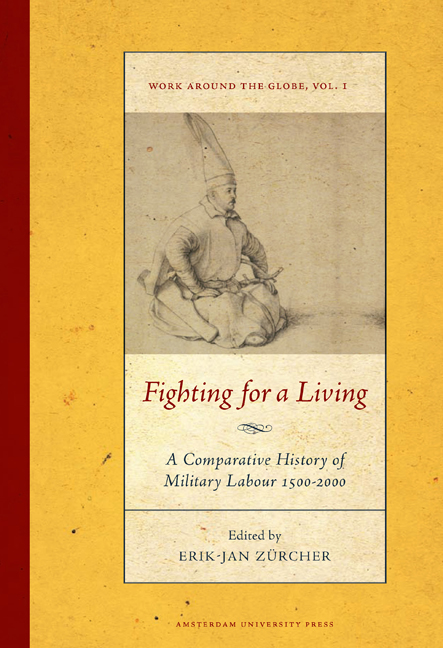Book contents
- Frontmatter
- Dedication
- Contents
- Preface
- Introduction: Understanding Changes in Military Recruitment and Employment Worldwide
- Military Labor in China, c. 1500
- From the Mamluks to the Mansabdars: A Social History of Military Service in South Asia, c. 1500 to c. 1650
- On the Ottoman Janissaries (Fourteenth-nineteenth Centuries)
- Soldiers in Western Europe, c. 1500-17901
- The Scottish Mercenary as a Migrant Labourer in Europe, 1550-1650
- Change and Continuity in Mercenary Armies: Central Europe, 1650-1750
- Peasants Fighting for a Living in Early Modern North India
- “True to Their Salt”: Mechanisms for Recruiting and Managing Military Labour in the Army of the East India Company During the Carnatic Wars in India
- “The Scum of Every County, the Refuse of Mankind”: Recruiting the British Army in the Eighteenth Century
- Mobilization of Warrior Populations in the Ottoman Context, 1750-1850
- Military Employment in Qing Dynasty China
- Military Service and the Russian Social Order, 1649-1861
- The French army, 1789-1914: Volunteers, Pressed Soldiers, and Conscripts
- The Dutch Army in Transition: From All-volunteer Force to Cadre-militia Army, 1795-1830
- The Draft and Draftees in Italy, 1861-1914
- Nation-building, War Experiences, and European Models: The Rejection of Conscription in Britain
- Mobilizing Military Labor in the Age of Total War: Ottoman Conscription Before and During the Great War
- Soldiering as Work: The All-volunteer Force in the United States
- Private Contractors in War From the 1990s to the Present: A Review Essay
- Collective Bibliography
- Notes on Contributors
The Draft and Draftees in Italy, 1861-1914
Published online by Cambridge University Press: 12 December 2020
- Frontmatter
- Dedication
- Contents
- Preface
- Introduction: Understanding Changes in Military Recruitment and Employment Worldwide
- Military Labor in China, c. 1500
- From the Mamluks to the Mansabdars: A Social History of Military Service in South Asia, c. 1500 to c. 1650
- On the Ottoman Janissaries (Fourteenth-nineteenth Centuries)
- Soldiers in Western Europe, c. 1500-17901
- The Scottish Mercenary as a Migrant Labourer in Europe, 1550-1650
- Change and Continuity in Mercenary Armies: Central Europe, 1650-1750
- Peasants Fighting for a Living in Early Modern North India
- “True to Their Salt”: Mechanisms for Recruiting and Managing Military Labour in the Army of the East India Company During the Carnatic Wars in India
- “The Scum of Every County, the Refuse of Mankind”: Recruiting the British Army in the Eighteenth Century
- Mobilization of Warrior Populations in the Ottoman Context, 1750-1850
- Military Employment in Qing Dynasty China
- Military Service and the Russian Social Order, 1649-1861
- The French army, 1789-1914: Volunteers, Pressed Soldiers, and Conscripts
- The Dutch Army in Transition: From All-volunteer Force to Cadre-militia Army, 1795-1830
- The Draft and Draftees in Italy, 1861-1914
- Nation-building, War Experiences, and European Models: The Rejection of Conscription in Britain
- Mobilizing Military Labor in the Age of Total War: Ottoman Conscription Before and During the Great War
- Soldiering as Work: The All-volunteer Force in the United States
- Private Contractors in War From the 1990s to the Present: A Review Essay
- Collective Bibliography
- Notes on Contributors
Summary
According to the Oxford English Dictionary, conscription is “compulsory enlistment for state service, typically into the armed forces”, while a conscript and a volunteer are respectively “a person enlisted compulsorily” and “a person who freely enrolls for military service rather than being conscripted”. Seemingly straightforward terms like these become, however, much trickier in the eye of the historian, who is always striving to historicize and compare apparently ubiquitous taxonomies and phenomena.
This chapter faces both challenges starting from the nineteenth-century Italian conscription experience. It will briefly analyze the draft system of pre-unification states, and then will reconstruct the evolution of Italian recruitment laws and practices from La Marmora's draft act (1854) to the eve of World War I. On the one hand, attention will be paid to the supposed shift from a professional-dynastic militia toward a draft-based army, in order to verify its linearity and the universality of Italian conscription. The chapter will show in particular how much the draft changed according to current political concerns and internal security needs. At the same time, it will highlight some constants in Italian conscription, such as the discriminatory nature of the system and the government's ambiguous attitude toward draftees. On the other hand, the chapter will approach military service in terms of labor relations between the army and reenlisted people. From this perspective, it will investigate who opted for soldiering as a form of employment and why, while trying to establish to what extent forced/voluntary and commodified/noncommodified military labor can be identified and disaggregated in the experience of nineteenth-century Italian soldiers.
A nation-state in progress: the long road to unification 1814-1858
Although most pre-unification Italian states relied on semiprofessional dynastic militias and mercenary troops, the postunification draft did not start from scratch, and its history is inseparably linked to that of the previous recruitment systems in force on the peninsula.
Starting in 1815, roughly 30,000 Italian-speaking subjects from Lombardy and Venetia were recruited yearly into the Habsburg army (8.5-10 per cent of the peacetime force), and normally served for eight years in Italian garrisons. In the Duchies of Modena and Parma, the law stated that young men were obligated to fulfill their military service in person. In practice, however, the armies were composed primarily of volunteers and substitutes – namely, men paid to replace draftees in the service.
- Type
- Chapter
- Information
- Fighting for a LivingA Comparative Study of Military Labour 1500–2000, pp. 479 - 518Publisher: Amsterdam University PressPrint publication year: 2013
- 2
- Cited by

